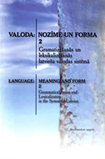Darbības vārds SACĪT un netiešas informācijas izteikšana
The Verb SACĪT and the Marking of Indirectly Expressed Information
Author(s): Liene KalvišaSubject(s): Language and Literature Studies, Theoretical Linguistics, Baltic Languages
Published by: Latvijas Universitātes Akadēmiskais apgāds
Keywords: evidencialitāte; gramatizēšanās; netieši saņemta informācija; informācijas avots; leksiskā nozīme;
Summary/Abstract: Evidentiality is associated with one of the semantic parameters of the statement, namely, with the reference to the source of information. It is semantic category, whose primary meaning is to indicate the source of information. Evidentiality is traditionally divided in two main categories:1 direct evidentiality, which shows that the speaker has directly witnessed the action;2 indirect evidentiality, which shows that the speaker has no direct evidence for his/her statement, but has other sources for making the statement (for example, information is reported or inferred).There can be different levels of the source of indirectly received information – the source can be specific and it can be general as well. The use of markers of indirectly received information is one of the main parts of everyday communication and language system in general. This article pays attention to the indirect evidentiality and its manifestation in Latvian and the analysis include the verb sacīt (‘to say’) and its connection with evidentiality, as well as the process of grammaticalization of this verb. The article presents the analysis of different types of reported information and the semantics of the verb sacīt in different contexts and syntactic constructions. Markers of reported evidentiality often come from grammaticalized verbs. The verb form saka and its construction kā saka in specific syntactic and semantic conditions can be used as grammatical markers of evidentiality in Latvian.
Journal: Valoda: nozīme un forma
- Issue Year: 2012
- Issue No: 2
- Page Range: 86-93
- Page Count: 8
- Language: Latvian

